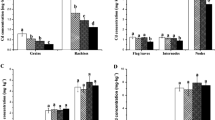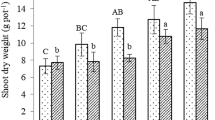Abstract
Heavy metals (HMs) especially cadmium (Cd) absorbed by the roots of crop plants like maize have emerged as one of the most serious threats by causing stunted plant growth along with disturbing the photosynthetic machinery and nutrient homeostasis process. A trial was conducted for inducing Cd stress tolerance in maize by exogenous application of silicon nanoparticles (SiNPs) using five doses of SiNPs (0, 100, 200, 300, and 400 ppm) and three levels of Cd (0, 15, and 30 ppm) for maize hybrid (SF-9515). The response variables included morphological traits and biochemical parameters of maize. The results indicated that Cd level of 30 ppm remained the most drastic for maize plants by recording the minimum traits such as shoot length (39.35 cm), shoot fresh weight (9.52 g) and shoot dry weight (3.20 g), leaf pigments such as chlorophyll a (0.55 mg/g FW), chlorophyll b (0.27 mg/g FW), total contents (0.84 mg/g FW), and carotenoid contents (0.19 µg/g FW). Additionally, the same Cd level disrupted biochemical traits such as TSP (4.85 mg/g FW), TP (252.94 nmol/g FW), TSAA (18.92 µmol g−1 FW), TSS (0.85 mg/g FW), and antioxidant activities such as POD (99.39 min−1 g−1 FW), CAT (81.58 min−1 g−1 FW), APX (2.04 min−1 g−1 FW), and SOD (172.79 min−1 g−1 FW). However, a higher level of Cd resulted in greater root length (87.63 cm), root fresh weight (16.43 g), and root dry weight (6.14 g) along with higher Cd concentration in the root (2.52 µg/g−1) and shoot (0.48 µg/g−1). The silicon nanoparticles (Si NPs) treatment significantly increased all measured attributes of maize. The highest value was noted of all the parameters such as chlorophyll a (0.91 mg/g FW), chlorophyll b (0.57 mg/g FW), total chlorophyll contents (1.48 mg/g FW), total carotenoid contents (0.40 µg/g FW), TSP (6.12 mg/g FW), TP (384.56 nmol/g FW), TSAA (24.64 µmol g−1 FW), TSS (1.87 mg/g FW), POD (166.10 min−1 g−1 FW), CAT (149.54 min−1 g−1 FW), APX (3.49 min−1 g−1 FW), and SOD (225.57 min−1 g−1 FW). Based on recorded findings, it might be inferred that higher levels of Cd tend to drastically reduce morpho-physiological traits of maize and foliage-applied silver nanoparticles hold the potential to ameliorate the adverse effect of Cd stress on maize.





Similar content being viewed by others
Data availability
The raw data are available and will be provided on demand.
Abbreviations
- HMs:
-
Heavy metals
- CRD:
-
Complete randomized design
- Si:
-
Silicon
- Si NPs:
-
Silicon nanoparticles
- TSP:
-
Total soluble protein
- TP:
-
Total proline
- TSAA:
-
Total soluble amino acid
- TSS:
-
Total soluble sugar
- POD:
-
Peroxidase dismutase
- CAT:
-
Catalase
- APX:
-
Ascorbate peroxidase
- SOD:
-
Superoxide dismutase
- Cd:
-
Cadmium
- ROS:
-
Reactive oxygen species
References
Abd El-Mageed TA, Shaaban A, Abd El-Mageed SA et al (2020) Silicon defensive role in maize (Zea mays L.) against drought stress and metals-contaminated irrigation water. Silicon. https://doi.org/10.1007/s12633-020-00690-0
Ahmad Z, Waraich EA, Ur Rehman MZ et al (2021) Foliar application of phosphorus enhances photosynthesis and biochemical characteristics of maize under drought stress. Phyton (B Aires) 90:503–514. https://doi.org/10.32604/phyton.2021.013588
Arguedas M, Gómez D, Hernández L et al (2018) Maize seed cryo-storage modifies chlorophyll, carotenoid, protein, aldehyde and phenolics levels during early stages of germination. Acta Physiol Plant 40:118. https://doi.org/10.1007/s11738-018-2695-7
Assay L (1951) proteins (Lowry) protocol 1. introduction the “Lowry Assay: Protein by Folin Reaction” Lowry. 5:1–5
Bates LS, Waldren RP, Teare ID (1973) Rapid determination of free proline for water stress studies. Plant Soil 207:205–207
Cakmak I, Hengeler C, Marschner H (1994) Changes in phloem export of sucrose in leaves in response to phosphorus, potassium and magnesium deficiency in bean plants. J Exp Bot 45:1251–1257. https://doi.org/10.1093/jxb/45.9.1251
Chance B, Maehly AC (1955) [136] Assay of catalases and peroxidases. {black small square}. Methods Enzymol 2:764–775. https://doi.org/10.1016/S0076-6879(55)02300-8
Dresler S, Wójcik M, Bednarek W et al (2015) The effect of silicon on maize growth under cadmium stress. Russ J Plant Physiol. https://doi.org/10.1134/S1021443715010057
Hamilton PB (1965) Amino acids on hands. Nature 205:284–285
Hayat S, Hayat Q, Alyemeni MN et al (2012) Role of proline under changing environments: A review. Plant Signal Behav 7:37–41. https://doi.org/10.4161/psb.21949
Hussain S, Shuxian L, Mumtaz M, Shafiq I, Iqbal N, Brestic M, Shoaib M, Sisi Q, Li W, Mei X, Bing C (2021) Foliar application of silicon improves stem strength under low light stress by regulating lignin biosynthesis genes in soybean (Glycine max (L.) Merr.). J Hazard Mater 401:123256. https://doi.org/10.1016/j.jhazmat.2020.123256
Iavicoli I, Leso V, Beezhold DH, Shvedova AA (2017) Nanotechnology in agriculture: Opportunities, toxicological implications, and occupational risks. Toxicol Appl Pharmacol 329:96–111. https://doi.org/10.1016/j.taap.2017.05.025
Jamil M, Ali A, Gul A et al (2019) Genome-wide association studies of seven agronomic traits under two sowing conditions in bread wheat. BMC Plant Biol 19:149. https://doi.org/10.1186/s12870-019-1754-6
Khan MA, Khan S, Khan A, Alam M (2017) Soil contamination with cadmium, consequences and remediation using organic amendments. Sci Total Environ 601–602:1591–1605. https://doi.org/10.1016/j.scitotenv.2017.06.030
Khan ZS, Rizwan M, Hafeez M et al (2019) Effects of silicon nanoparticles on growth and physiology of wheat in cadmium contaminated soil under different soil moisture levels. Environ Sci Pollut Res 27:4958–4968. https://doi.org/10.1007/s11356-019-06673-y
Khan I, Awan SA, Rizwan M, Ali S, Hassan MJ, Brestic M, Zhang X, Huang L (2021) Effects of silicon on heavy metal uptake at the soil-plant interphase: A review. Ecotoxicol Environ Saf 222:112510
Ling T, Gao Q, Du H et al (2017) Growing, physiological responses and Cd uptake of Corn (Zea mays L.) under different Cd supply. Chem Speciat Bioavailab 29:216–221. https://doi.org/10.1080/09542299.2017.1400924
Lukačová Z, Švubová R, Kohanová J, Lux A (2013) Silicon mitigates the Cd toxicity in maize in relation to cadmium translocation, cell distribution, antioxidant enzymes stimulation and enhanced endodermal apoplasmic barrier development. Plant Growth Regul 70:89–103. https://doi.org/10.1007/s10725-012-9781-4
Moradi P, Vafaee Y, Mozafari AA, Tahir NAR (2022) Silicon Nanoparticles and Methyl Jasmonate Improve Physiological Response and Increase Expression of Stress-related Genes in Strawberry cv. Paros Under Salinity Stress. Silicon. https://doi.org/10.1007/s12633-022-01791-8
Qiao M, Xu Y, Xia G et al (2022) Determination of hardness for maize kernels based on hyperspectral imaging. Food Chem 366:130559. https://doi.org/10.1016/j.foodchem.2021.130559
Rastogi A, Tripathi DK, Yadav S, Chauhan DK, Zivčák M, Ghorbanpour M, El-Sheery NI, Brestic M (2019) Application of silicon nanoparticles in agriculture. 3 Biotech 9:90. https://doi.org/10.1007/s13205-019-1626-
Rehman MZU, Rizwan M, Ghafoor A, Naeem A, Ali S, Sabir M, Qayyum MF (2015) Effect of inorganic amendments for in situ stabilization of cadmium in contaminated soils and its phyto-availability to wheat and rice under rotation. Environ Sci Pollut Res 22(21):16897–16906. https://doi.org/10.1007/s11356-015-4883-y
Seregin IV, Shpigun LK, Ivanov VB (2004) Distribution and toxic effects of cadmium and lead on maize roots. Russ J Plant Physiol. https://doi.org/10.1023/B:RUPP.0000035747.42399.84
Shafeeq-ur-Rahman XQ, Yatao X et al (2020) Silicon and Its Application Methods Improve Physiological Traits and Antioxidants in Triticum aestivum (L.) Under Cadmium Stress. J Soil Sci Plant Nutr 20:1110–1121. https://doi.org/10.1007/s42729-020-00197-y
Siddiqui H, Ahmed KBM, Sami F, Hayat S (2020) Silicon Nanoparticles and Plants: Current Knowledge and Future Perspectives. 129–142. https://doi.org/10.1007/978-3-030-33996-8_7
Steel Z, Blaszczynski A (1998) Impulsivity, personality disorders and pathological gambling severity. Addiction 93:895–905. https://doi.org/10.1046/j.1360-0443.1998.93689511.x
Thind S, Hussain I, Ali S et al (2021) Silicon Application Modulates Growth, Physio-Chemicals, and Antioxidants in Wheat (Triticum aestivum L.) Exposed to Different Cadmium Regimes. Dose-Response 19:1–15. https://doi.org/10.1177/15593258211014646
Tripathi DK, Singh S, Singh VP et al (2017) Silicon nanoparticles more effectively alleviated UV-B stress than silicon in wheat (Triticum aestivum) seedlings. Plant Physiol Biochem 110:70–81. https://doi.org/10.1016/j.plaphy.2016.06.026
ur Rehman MZ, Zafar M, Waris AA, Rizwan M, Ali S, Sabir M, Usman M, Ayub MA, Ahmad Z (2020) Residual effects of frequently available organic amendments on cadmium bioavailability and accumulation in wheat. Chemosphere 244:125548. https://doi.org/10.1016/j.chemosphere.2019.125548
Xu X, Luo P, Li S et al (2022) Distributions of Heavy Metals in Rice and Corn and Their Health Risk Assessment in Guizhou Province. Bull Environ Contam Toxicol. https://doi.org/10.1007/s00128-021-03407-0
Yan X, An J, Yin Y et al (2022) Heavy metals uptake and translocation of typical wetland plants and their ecological effects on the coastal soil of a contaminated bay in Northeast China. Sci Total Environ 803:149871. https://doi.org/10.1016/j.scitotenv.2021.149871
Yang Z, Chen J, Dou R et al (2015) Assessment of the phytotoxicity of metal oxide nanoparticles on two crop plants, maize (Zea mays L.) and rice (Oryza sativa L.). Int J Environ Res Public Health. https://doi.org/10.3390/ijerph121214963
Yemm EW, Willis AJ (1954) The Estimation of Carbohydrates in Plant Extracts by Anthrone. Int J Pharm Pract 7:197. https://doi.org/10.1111/j.2042-7174.1999.tb00969.x
Zhang C, Zeng G, Huang D, Lai C, Huang C, Li N, Xu P, Cheng M, Zhou Y, Tang W, He X (2014) Combined removal of di (2-Ethylhexyl) phthalate (DEHP) and Pb(ii) by using a cutinase loaded nanoporous gold-polyethyleneimine adsorbent. RSC Adv 4:55511–55518. https://doi.org/10.1039/c4ra09563d
Zhao H, Guan J, Liang Q, Zhang X, Hu H, Zhang J (2021) Effects of cadmium stress on growth and physiological characteristics of sassafras seedlings. Sci Rep 11(1):1–11. https://doi.org/10.1038/s41598-021-89322-0
Acknowledgements
The authors gratefully acknowledge technical and financial support provided by the Ministry of Education and King Abdulaziz University, DSR, Jeddah, Saudi Arabia. We are thankful to University of Central Punjab Constituent College Yazman Road Bahawalpur for sharing lab facilities and providing space for research experiments.
Funding
This work was funded by Institutional Fund Projects under grant No. (IFPIP: 439–130-1443), Ministry of Education in Saudi Arabia.
Author information
Authors and Affiliations
Contributions
ZA and MI planned and supervised the research; SA conducted the research work and wrote the introduction part; ZA wrote the manuscript; SA and ZA did the static analysis and graphical representation; MAI and HFA read the manuscript as proofreading and arranged it according to the journal style; AA provided reagents and assisted in the analytical work; and AH and AES did the editing and improved the English language quality of the manuscript.
Corresponding author
Ethics declarations
Ethical approval
All authors approve this manuscript for submission to Environmental Science and Pollution Research.
Consent to participate
All authors participate in the preparation of the manuscript.
Consent for publication
All authors consent to the manuscript published in Environmental Science and Pollution Research.
Competing interests
The authors declare no competing interests.
Additional information
Responsible Editor: Gangrong Shi
Publisher's note
Springer Nature remains neutral with regard to jurisdictional claims in published maps and institutional affiliations.
Rights and permissions
Springer Nature or its licensor (e.g. a society or other partner) holds exclusive rights to this article under a publishing agreement with the author(s) or other rightsholder(s); author self-archiving of the accepted manuscript version of this article is solely governed by the terms of such publishing agreement and applicable law.
About this article
Cite this article
Ahmed, S., Iqbal, M., Ahmad, Z. et al. Foliar application of silicon-based nanoparticles improve the adaptability of maize (Zea mays L.) in cadmium contaminated soils. Environ Sci Pollut Res 30, 41002–41013 (2023). https://doi.org/10.1007/s11356-023-25189-0
Received:
Accepted:
Published:
Issue Date:
DOI: https://doi.org/10.1007/s11356-023-25189-0




